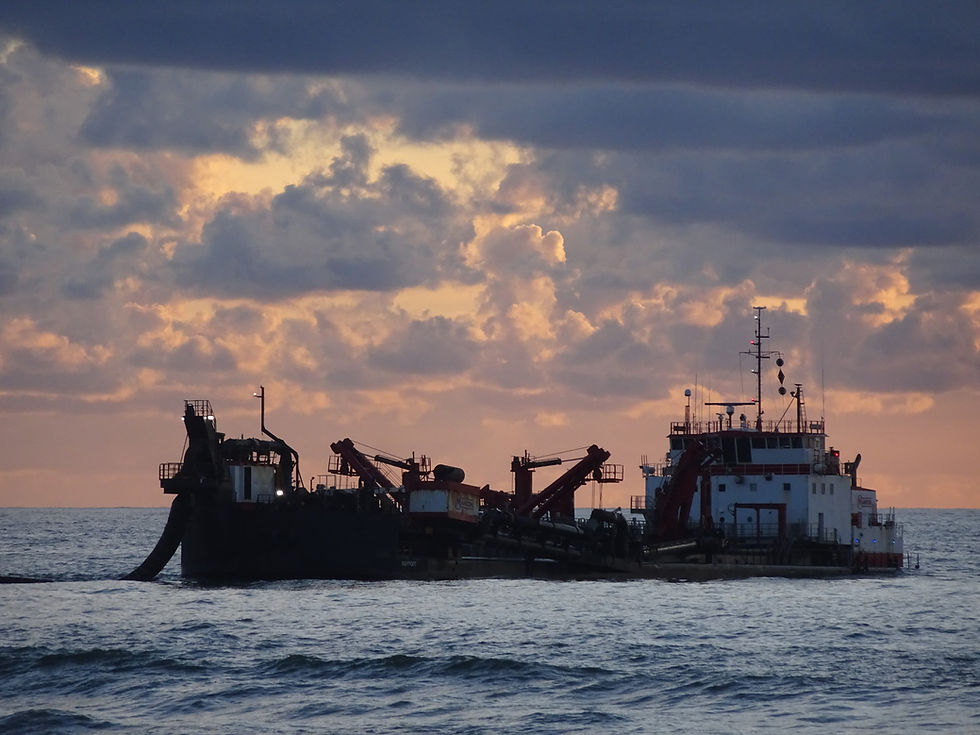Dredging and Beach Nourishment: How Manson Improves Coastal Environments
- J.Anthony Tedpahogo

- Apr 18, 2024
- 2 min read
While beaches are popular attractions for the public, they primarily serve as live ecosystems supporting coastal biodiversity. Beaches are also the first barrier of defense for wildlife, marine infrastructure, and coastal communities from powerful waves, wind, and storm surges—a barrier that sometimes requires a little routine maintenance.
Additionally, more than 40,000 marine vessels rely on navigable waterways in the U.S. to transport goods and supplies coast-to-coast to more than 19,000 cities, according to the American Maritime Partnership.
Manson helps to maintain the depths of these navigation channels through the process of dredging to remove built up material from the bottom of the seafloor, providing safe passage for ships, improvements to infrastructure, and support to natural marine habitats.
“Dredging protects the waterways, coastal infrastructure, and at the same time improves the life of endangered species,” says Mike Warwick, Manson Vice President & Chief Engineer of Dredging. “We are really at the front lines of improving the environment and providing communities protection from the effects of climate change.”
The removal process helps to restore the coastal environment cleaning up trash and human-caused waste to mitigate environmental harms.

Among the many benefits of dredging U.S. channels, the dredged material can be repurposed to nourish beaches that suffer from coastal erosion—the natural process of sand removed by waves.
Manson is currently working in Southern California to nourish two popular beaches, Solana and Encinitas—neighboring cities near San Diego, CA which see approximately 3 million beachgoers per year—as part of the FY23 West Coast Hopper Maintenance Dredging project.
An important project for the United States Army Corps of Engineers (USACE) Portland and Los Angeles Districts and the Solana and Encinitas communities, the project is the first part of a 50-year plan to maintain the coastline, every 10 years for Solana and every five years for Encinitas.
“Solana and Encinitas beaches have experienced heavy rain and strong wave action during recent winters,” says Lead Engineer Taylor McRae. “There was hardly any beach at Solana and Encinitas was covered in rocks. Also, Solana and Encinitas have houses that are built on top of bluffs, meaning these communities were at risk of oversaturated bluffs that could potentially turn into landslides, so this was an important project for everyone involved.”
In January 2024, the project team and crew of the hopper dredge BAYPORT began dredging and pumping material from a designated borrow site onto Solana beach, while beach crews spread and graded sand with excavators throughout the area.

To the anticipation and excitement of residents and tourists waiting to dig their toes in the fresh sand, the project team widened the beach to 150 ft. stretching over 1.3 miles in only two months.
After wrapping up at Solana Beach, Manson moved 5 miles north to Encinitas to begin the next section of dredging and beach nourishment. Beach filling will extend to other popular locations, including Swami’s Beach and Beacon’s Entrance Beach. The pumped material will replace the rock-infested area and widen the coastline by more than 50 ft.
“We finished Solana beach ahead of schedule,” Taylor explains. “We have heard nothing but wonderful things from the public and the City of Solana about the work we have completed. We opened the beach to the public, and even some people from the Manson project team spent time together at the beach. I am proud of the work we have performed and its rewarding to be able to enjoy it too.”




Comments